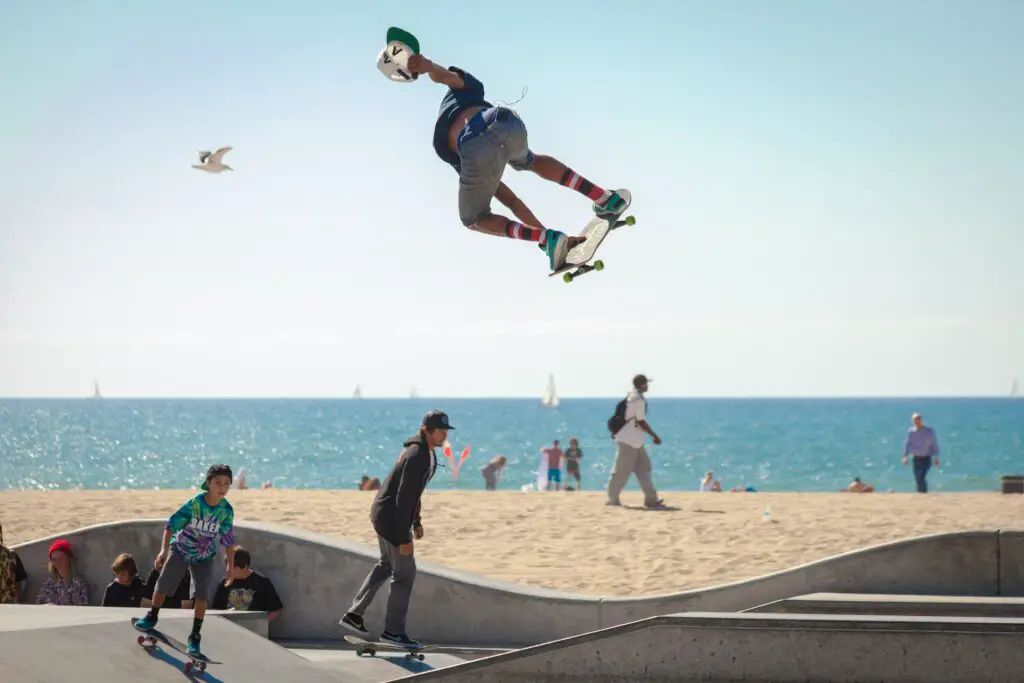
How to stay safe while skateboarding with kids. Are you looking for a fun and exciting way to spend time with your kids? Skateboarding can be a great activity for the whole family to enjoy together. Not only is it a great way to get exercise, but it also helps build coordination and balance skills. However, like any activity, skateboarding does come with some risks. As a parent, it’s important to take steps to keep your children safe while skateboarding. In this article, I’ll share some tips on how you can stay safe while skateboarding with your kids, so you can have a fun and worry-free experience. Let’s get started!
Importance of Safety
As a parent, the safety of your child is always a top priority. When it comes to skateboarding, it’s important to remember that this activity comes with its own set of risks.
While it can be a fun and exciting activity, it’s essential to take steps to keep your child safe while they enjoy skateboarding.
Accidents can happen, but by taking precautions, you can minimize the risk of injury and ensure that your child has a safe and enjoyable experience.
In this article, I’ll share some tips on how to keep your child safe while skateboarding, so you can feel confident and worry-free while they have fun.
Benefits of Skateboarding
Skateboarding is not just a fun activity for kids, it also offers a range of benefits for their physical and mental well-being.
Not only does it provide a great cardiovascular workout, but it also helps build strength, balance, and coordination skills. Plus, it’s a great way to get kids outside and active, away from screens and technology.
Skateboarding also promotes creativity and encourages kids to express themselves through tricks and maneuvers.
It’s a great way for kids to challenge themselves, build self-confidence, and improve their problem-solving skills.
By encouraging your child to try skateboarding, you’re giving them the opportunity to develop important life skills while having fun at the same time.
Risks of Skateboarding
While skateboarding can be a fun and exciting activity, it’s important to be aware of the risks involved. Falls and collisions can happen, and they can lead to serious injuries if the proper safety precautions aren’t taken.
Common injuries from skateboarding include broken bones, sprains, and cuts and bruises.
It’s also important to keep in mind that skateboarding can be dangerous if done in the wrong places or in the wrong way, such as on busy streets or without proper safety gear.
However, with the right safety measures in place, the risks of skateboarding can be greatly minimized, and your child can have a fun and safe experience.
In the following sections, I’ll share some tips on how you can keep your child safe while skateboarding.
Steps to Stay Safe
As a parent, keeping your child safe is probably one of your top priorities. While we can’t always control everything that happens around us, there are some steps we can take to minimize risks and keep our kids safe.
First, make sure your child knows their full name, address, and phone number so they can reach out for help if needed. Next, teach your child about “stranger danger” and how to say no if someone makes them feel uncomfortable or unsafe.
You can also establish clear rules for using the internet and social media, such as not sharing personal information or chatting with strangers.
Finally, make sure your home is a safe environment by keeping dangerous items out of reach and having working smoke detectors and carbon monoxide detectors.
By taking these simple steps, you can help protect your child and give yourself peace of mind.
Safety Gear for Kids
As a parent, it’s important to keep our kids safe in any activity they’re engaged in, and that’s where safety gear comes in.
From biking to skateboarding to playing contact sports, there are a variety of safety gear options available to help protect your child from injury.
For example, a properly fitting helmet is a must-have for any activity that involves a risk of head injury. Knee and elbow pads can also help prevent bruises and scrapes.
Mouthguards are essential for contact sports to prevent dental injuries, and protective eyewear can prevent eye injuries in sports like basketball or racquetball.
Don’t forget about reflective gear and lights for activities like biking or walking in low-light conditions.
By investing in the right safety gear, you can help reduce the risk of serious injury and give your child the confidence they need to enjoy their activities safely.
Proper Skateboard Selection
Skateboarding can be a fun and exciting activity for kids, but it’s important to choose the right skateboard to ensure their safety and enjoyment. When selecting a skateboard, consider the size and weight of your child.
A skateboard that is too big or too small can be difficult to control and lead to accidents. Look for a skateboard with a sturdy deck made of high-quality materials that can support your child’s weight.
Wheels should also be considered – larger wheels are better for cruising, while smaller wheels are better for tricks. Make sure to also choose appropriate safety gear, such as a helmet and knee and elbow pads.
It’s also a good idea to buy from a reputable brand or shop and avoid purchasing second-hand skateboards, which may have hidden damage or wear.
With the right skateboard and safety gear, your child can enjoy a safe and exciting skating experience.
Skateboarding Etiquette
Skateboarding is a fun and social activity, but it’s important to know the proper etiquette when out on the streets or at a skate park.
First and foremost, always be aware of your surroundings and stay in control of your board to avoid colliding with others. If you’re at a skate park, be sure to take turns and wait your turn in line for obstacles.
When someone falls or needs help, always offer a hand and make sure they’re okay. It’s also important to respect others and their space – avoid cutting in front of others or hogging a particular spot.
Finally, be mindful of the environment and pick up any trash or debris before you leave.
By following these simple guidelines, you can have a positive and enjoyable skating experience while also respecting others and the environment around you.
Importance of Supervision
As a parent, it’s important to provide proper supervision for your child to ensure their safety and well-being.
Whether your child is playing in the backyard or riding their bike around the neighborhood, having an adult present can help prevent accidents and provide guidance when needed.
Supervision is especially important when it comes to activities that carry a higher risk of injury, such as swimming or playing contact sports.
By being present and attentive, you can help prevent accidents and provide quick assistance if needed.
Additionally, supervision can also help teach your child important safety skills, such as looking both ways before crossing the street or wearing a helmet when riding a bike.
So make sure to always provide proper supervision for your child, and give yourself peace of mind knowing they are safe and protected.

Fun and Safe Skateboarding Experience
Skateboarding is a fun and exciting activity that can provide hours of enjoyment for kids. But it’s important to make sure that they have a safe and positive experience while skateboarding.
To start, make sure your child has the proper safety gear, including a helmet, knee and elbow pads, and possibly even wrist guards.
Encourage your child to learn the basics of skateboarding in a safe and controlled environment, such as a skate park or empty parking lot.
Be sure to also teach them about skateboarding etiquette, such as being aware of their surroundings and taking turns.
And always supervise your child while they’re skateboarding to ensure their safety and provide guidance when needed.
Finally, remind your child that skateboarding can be a lot of fun, but they should never take unnecessary risks or attempt tricks beyond their skill level.
By following these tips, your child can have a fun and safe skateboarding experience.
Conclusion
As a parent, it’s important to prioritize your child’s safety while also encouraging them to have fun and enjoy their favorite activities.
Whether it’s skateboarding, biking, or playing sports, providing proper supervision and safety gear can help prevent accidents and ensure a positive experience for your child.
Additionally, teaching your child about proper etiquette and respecting others can help them become responsible and respectful individuals.
So go ahead and encourage your child to pursue their interests and hobbies, while also making sure that they have the necessary tools and guidance to stay safe and protected.
Frequently Asked Questions(FAQ)
What safety precautions should I take when skateboarding with my child?
Prioritize safety gear for both you and your child, including helmets, knee pads, elbow pads, and wrist guards. Ensure the skateboard is in good condition, and choose safe practice areas away from traffic.
At what age can I start skateboarding with my child?
You can start skateboarding with your child once they have the balance and coordination to ride safely. Most children can begin around 5-6 years old, but it varies from child to child.
How can I teach my child to skateboard safely?
Start with the basics like balance and pushing. Teach them to use safety gear and the rules of the road if skateboarding in public areas. Encourage them to practice in designated skate parks or safe, flat areas.
What should I do if my child falls while skateboarding?
If your child falls, assess the situation and check for injuries. Encourage them to get back up if they’re okay, but seek medical attention for any significant injuries. Always carry a basic first-aid kit while skateboarding.
How can I ensure a safe and enjoyable skateboarding experience with my child?
-
- Supervise your child closely, especially if they are young or just starting.
- Set a positive example by wearing safety gear yourself.
- Choose appropriate skateboarding locations, such as skate parks or smooth, quiet streets.
- Promote communication with your child, so they feel comfortable discussing any concerns or issues related to skateboarding.
- Encourage a fun and supportive atmosphere that focuses on skill development and safety.

